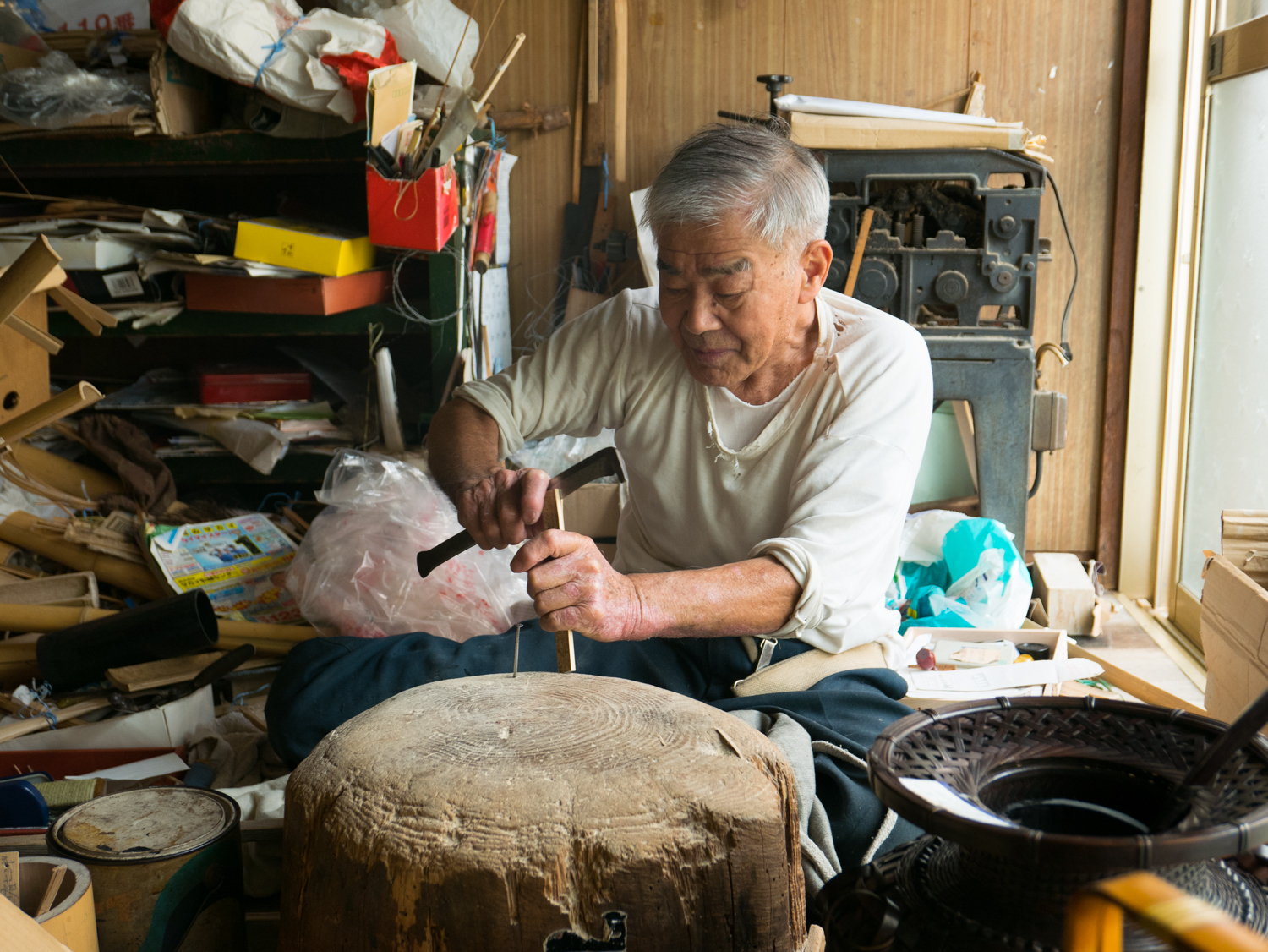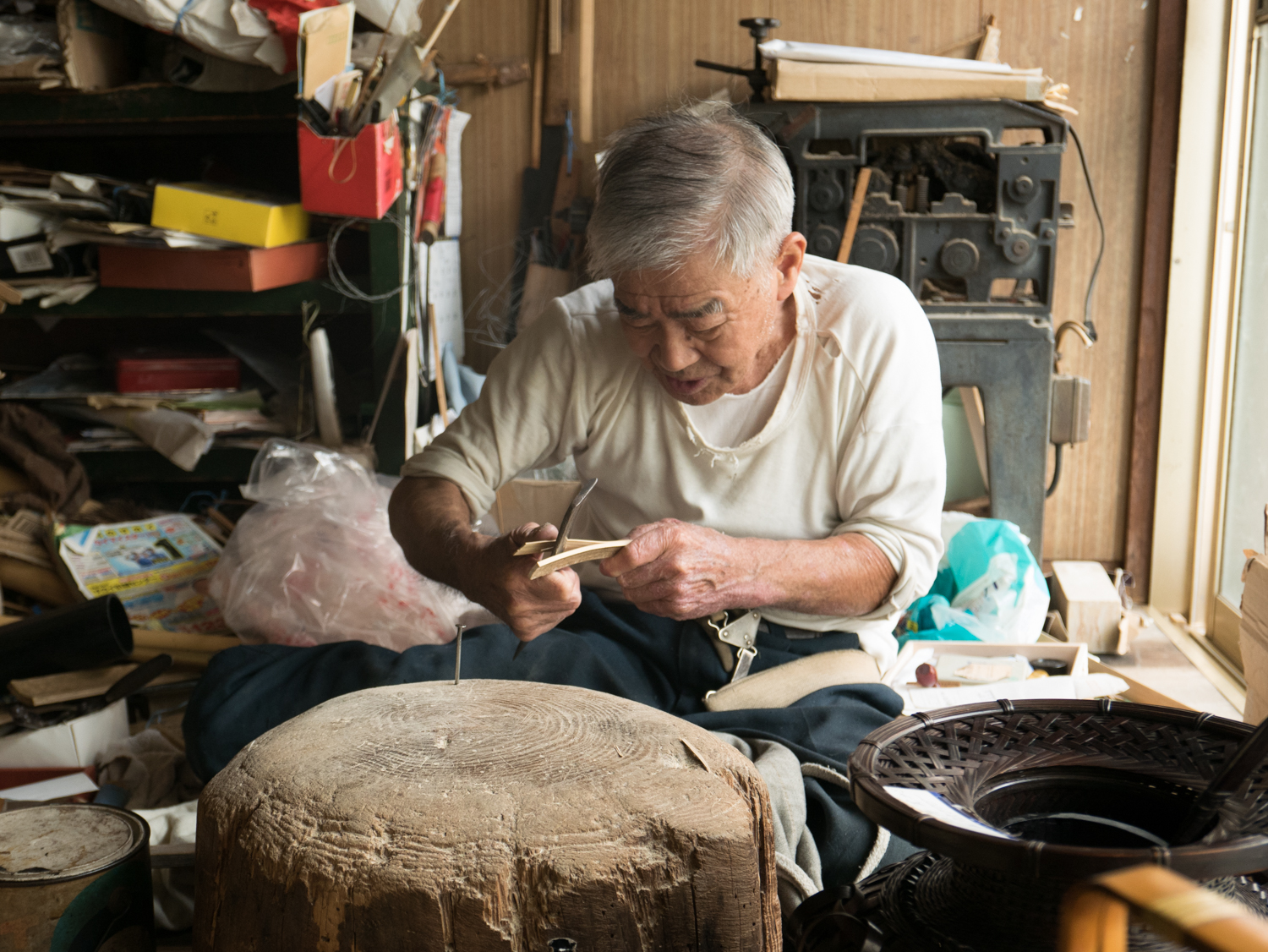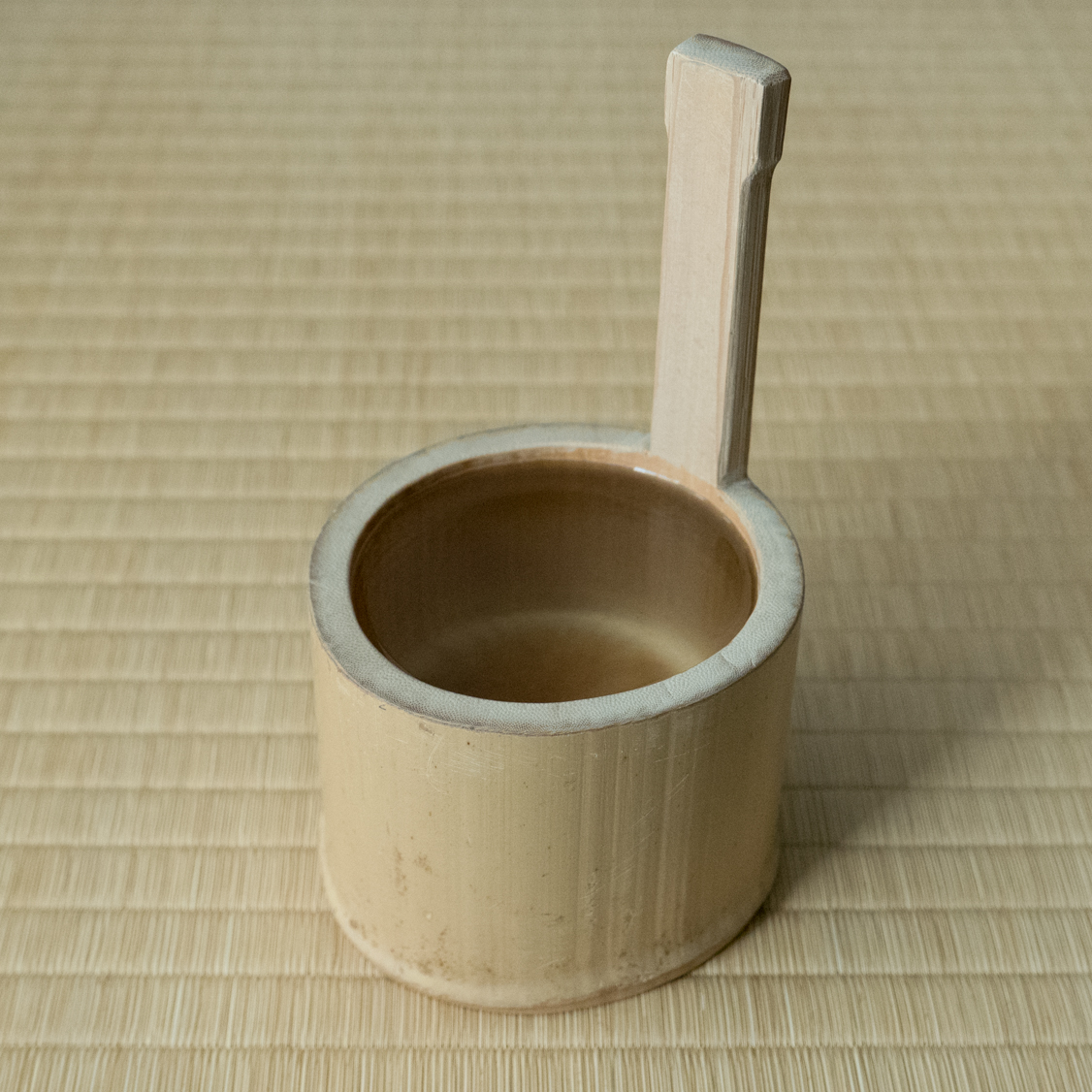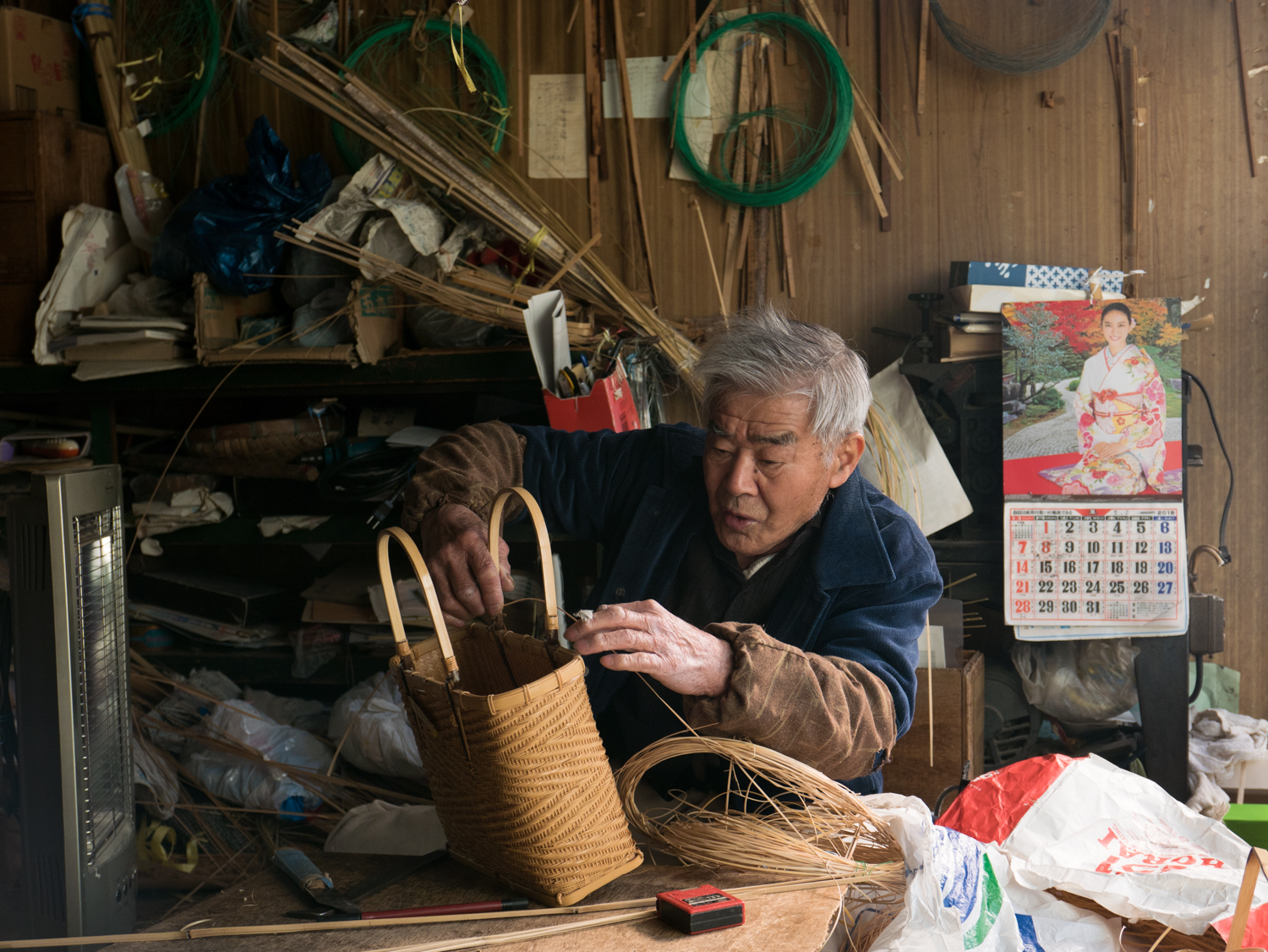
鹿児島市内を出ると折り重なるように幾つも小山が続いた。山は暗い色の樹木に覆われ山間には
狭い耕地を持った小さな集落が点在していた。時より風で大きく揺れる竹林の他は静かだった。
百年くらい変わらない光景のように感じた。
薩摩川内市樋脇町市比野にある田中實男さんの店を初めて訪ねたのは夏の日だった。田中商店は
思ってたより大きく、金物や日曜大工用品を扱うような感じの店だった。人の気配もなく灯りも
ついて居なかったが、硝子サッシの向こうには其処此処に笊や竹籠類が乱雑に放置してあるのが
見え一層興味をそそった。
脚が悪くて店には下りていけないよ。奥から小さな声が聞こえた。夏風邪をひいて体調を崩して
いるらしい。暑さが堪えていると言った。東京から来たと告げると、昔は東京や大阪のデパート
の物産展によく出たが売れなかった、売れるのは食べ物だけだ。
問わず語りに時々生返事をしながら僕は店内を隅々まで物色していた。多くは笊、箕、籠、魚籠
等の道具類だった。小豆が落ちるくらいの笊は恐ろしく均一に目が整えられていた。総じて手が
綺麗で几帳面な仕事ぶりがうかがえた。日用品の中に竹二段重、三段重などの少し体裁の良い品
も混じってた。そして花器や茶道具、ハンドバッグでは現代の名工の卓越した技で編まれた繊細
で優美な作品を目にする事が出来た。
「この仕掛けを下さい」「よく鰻が入るよ」「この辺で鰻が獲れるんですか」「昔はよく獲れた」
「幾らかな」「3,500円って書いてあります」「じゃ3,500円」。
そして「この桶もらってもいいですか」と言うと、どれと言って僕から桶を取りあげた。そして
少し眺めてから1,000円と言った。僕はタダでくれるかと思っていた。何故ならそれは段ボール
箱にボロ裂と一緒に放ってあった物で、全体的に酷く汚れ、埃が数センチも中に溜まって放って
あったから。けれど名工はその桶に1,000円という値をつけた。僕はなんだか少し嬉しくなった。
次に田中さんを訪ねたのは秋だった。三ヶ月前は具合が悪そうでもう仕事はされていないのかも
知れないと思ったが午前中から仕事をされていた。驚いたのは田中さんの二の腕の太さ、手と指
のごつさだった。
田中さんは昭和五年に日置市で生まれたそうだ。輸送船で働いていたが、事故で左脚を失なった。
療養先から鹿児島に戻り職業訓練学校で九ヶ月間竹細工を学んだ。卒業後一時的に雇われた事は
あったが、誰かに師事した事はなく、経済的に貧窮しながらも独学で編む技術を付けたそうだ。
東京や大阪での実演販売の際、空いた時間は竹細工を方々見て廻った。眼で覚えて、頭で考え、
宿で寝る時も忘れないようにした。カメラは持っていなかった。 鹿児島に戻って手を動かして
その技を身に付けていった。
僕が特に気に入った籠がある。それは雑然とした作業場の片隅に置かれていた。何事も無い様な
懐かしい屑籠、田中さんはマガジン入れと言っていたけれども。やや尻すぼみの六角柱、綺麗な
フォルムに、均整整った麻目で編まれていた。竹には透明な拭き漆が施され質感も申し分ない。
「これは大変に難しいよ。今では、もうこういうのを編めるもんはおらん。よう編みあげん」。
年が変わって直ぐに三度目の訪問をした時に竹の行李を作って欲しいとお願いした。それは網代
編みではなく、筏底編みの伝統的な鹿児島の竹の重箱の様にして欲しいと。竹ひごは細過ぎず、
十分に強度を保つように重ねてお願いした。田中さんは何度も寸法を僕に確認したのち、試作を
作ってくれることになった。
試作は春には出来ていたのだが、鹿児島へ行けたのは六月に入っての事だった。田中さんは実に
色々なタイプの試作を作ってくれていた。奇麗だけどこちらの意図には沿わない物、機能的に今
ひとつと思われる物もあって、依頼する側の知識不足と意思疎通の不味さを反省するとともに、
忌憚なく新たに要望を言った。田中さんは別段嫌がるわけでも困るわけでもなく、一緒になって
最試作へ向けて細工を考えてくれた。またその値段だと売れないとか、そういった現実的な話も
友達同士のようにしていたのを思い出す。現代の名工、黄綬褒章受賞者ではあるが、小指の先程
もお高くとまったところがない太か名工だった。
海千山千會 立沢木守
1930年鹿児島県生まれ
鹿児島県薩摩川内市樋脇町市比野にて竹ひごを手作業で編む
編組物(へんそもの)の名工。
県知事賞、厚生労働大臣「卓越した技能者(現代の名工)」、
黄綬褒章受賞。




As soon as I left Kagoshima city, I was greeted by the sight of rolling hills that seemed to continue
on and on. They were covered by dark trees and small villages with narrow strips of farmland
dotted the areas in between. It was silent other than the occasional sound of bamboo trees swaying
in the wind. It felt like the scenery has remained unchanged for a century.
The first time I visited Minoru Tanaka’s store in Hiwakicho Ichihino, Satsumasendai, was in
summer. It was bigger than I expected and looked like a place that sold metal pieces and DIY items.
There was nobody inside and the lights were not turned on, but I could see some bamboo sieves and
baskets scattered here and there on the other side of the glass panel, which piqued my interest
further.
“I have a bad leg so I cannot come down,” I heard a small voice call out. Apparently, he had caught
a cold and was not feeling well. He added that he was struggling with the heat as well. When I told
him that I came from Tokyo, he replied that he used to join exhibitions for local products in
department stores in Tokyo and Osaka, but he could not sell his bamboo pieces there and people
were only interested in food products.
He began telling me stories and I would reply him every now and then as I wandered around his
store. Most of them were sieves, winnowing baskets, baskets, fish traps and other tools. I was
impressed to see that even the sieves that were only big enough for beans had evenly spaced holes.
All in all, I could tell that his handiwork was beautiful and meticulous. I also spotted slightly more
regular items such as two- and three-tiered bamboo boxes for day-to-day use, as well as delicate and
beautiful items that reveal the exceptional skills of a contemporary master craftsman such as vases,
tea sets, and handbags.
“I’d like to buy this hook, please,” I said.
“That’s good for catching eels.”
“Is it easy to catch eels here?”
“It used to be,” he replied. “Let’s see, how much was it?”
“It says here 3,500 yen,” I told him.
“3,500 yen it is then.”
I then asked him, “Can I have this bucket?”
He asked me which one and I lifted it up to show him. He looked it over and said that I could have
it for 1,000 yen. I thought he would give it to me for free because it was left in a cardboard box with
some old items. Overall, it was extremely dirty and a thick layer of dust had accumulated inside.
However, this master craftsman priced the bucket at 1,000 yen and that made me happy for some
reason.
The next time I visited Tanaka was in autumn. He seemed to be in poor health when I saw him three
months ago, so I thought he would not be taking any more jobs, but he had been working since
morning. Seeing his thick upper arm and tough hands and fingers caught me by surprise.
He was born in Hioki city, Kagoshima Prefecture, in 1930. He worked on a transport ship but lost
his left leg in an accident. After his rehabilitation, he came back to Kagoshima and studied bamboo
work for nine months in a vocational school. He found work for a period of time after he graduated,
but he did not study under anybody and learned about weaving techniques by himself even as he
struggled financially.
When he visited Tokyo and Osaka and demonstrated his skills while selling his wares, he would go
around and visit other bamboo craftsmen whenever he has free time. He had no camera so he would
observe them and go through it in his mind so as not to forget when he slept at night. He would then
work on the techniques he saw when he returned to Kagoshima in order to master them.
There was a particular basket that I liked. It was placed randomly in a corner. It was a simple waste
basket that looked familiar and Tanaka told me that it was for storing magazines. It was a slightly
tapered hexagonal prism with a beautiful form and woven symmetrically using Urticales. The
bamboo has a clear lacquer finish and a wonderful texture.
“That was extremely difficult (to make). Nobody can weave like that anymore these days,” he said.
I visited him for the third time at the start of the year and asked him to make a bamboo box. I told
him I did not want ajiro weaving but traditional weaving such as the one used to make Kagoshima
bamboo multi-tiered boxes. I asked for bamboo strips that are not too thin and have sufficient
strength. He confirmed the dimensions with me repeatedly before deciding to create a sample for us.
He finished it in spring, but I was only able to go down to Kagoshima again in June. I found out that
he had created many different samples. They were beautiful, but they were either not what I had
intended or somewhat lacking in functionality. I realized that it was due to my lack of knowledge in
this field and our miscommunication, but I explained our requirements again without reserve. He
was neither annoyed nor troubled by it, and worked together with us to create another sample. I also
remembered talking to him candidly like friends about practical issues such as how we will not be
able to sell the box at the price he was quoting.
Mr. Tanaka may be a contemporary master craftsman and a recipient of the Medal with Yellow
Ribbon, but he is a humble and big-hearted man.
By Kimamori Tachizawa
Born in Kagoshima Prefecture in 1930. A master weaver who weaves thin strips of bamboo by hand in Hiwakicho Ichihino, Satsumasendai, Kagoshima Prefecture. Recipient of the Prefectural Governor Award, Award for Outstandingly Skilled Workers (Contemporary Master Craftsman) from the Ministry of Health, Labour and Welfare, and the Medal with Yellow Ribbon.
